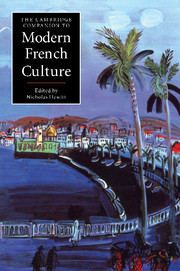Book contents
- Frontmatter
- Introduction: French culture and society in the twentieth century
- 1 Modern France: history, culture and identity, 1900-1945
- 2 Culture and identity in postwar France
- 3 Architecture, planning and design
- 4 The mass media
- 5 Consumer culture: food, drink and fashion
- 6 Language: divisions and debates
- 7 Intellectuals
- 8 Religion, politics and culture in France
- 9 The third term: literature between philosophy and critical theory
- 10 Narrative fiction in French
- 11 Poetry
- 12 Theatre
- 13 Music
- 14 The visual arts
- 15 Cinema
- Index
3 - Architecture, planning and design
Published online by Cambridge University Press: 28 May 2006
- Frontmatter
- Introduction: French culture and society in the twentieth century
- 1 Modern France: history, culture and identity, 1900-1945
- 2 Culture and identity in postwar France
- 3 Architecture, planning and design
- 4 The mass media
- 5 Consumer culture: food, drink and fashion
- 6 Language: divisions and debates
- 7 Intellectuals
- 8 Religion, politics and culture in France
- 9 The third term: literature between philosophy and critical theory
- 10 Narrative fiction in French
- 11 Poetry
- 12 Theatre
- 13 Music
- 14 The visual arts
- 15 Cinema
- Index
Summary
The historical foundations of French design
France entered the twentieth century with one of its greatest assets, a rich national culture, in full vigour. More than any other European country, French society set cultural standards which most creative people observed and the population respected. Since its origins under Henri IV (1589-1610) and Louis XIV (1643-1715), this comprehensive culture had been associated with national unity and power, formal training, and the dominance of Paris within French society.
Most French design was inspired from the late sixteenth century by an aesthetic derived from the Italian Renaissance, and given a clear national form from the seventeenth century by architects such as Mansart, Lemercier and Blondel. In this chapter the term 'classical' will be used to describe this aesthetic. It was a system of harmonious proportions, enhanced by details associated with the ancient world. It often made use of the classical orders but many features, such as turrets and steep roofs covered in slate, finials, filigree work, and massive fire surrounds, were medieval French. These traditional features had faded, however, by the late seventeenth century except in small towns and the countryside where tradition still dictated design. In the eighteenth century, symmetry, repetition, archaeological study of ancient remains, the classical orders, and precisely shaped masonry blocks, marked most new public buildings and the homes of the royalty and aristocracy.
- Type
- Chapter
- Information
- The Cambridge Companion to Modern French Culture , pp. 61 - 81Publisher: Cambridge University PressPrint publication year: 2003



